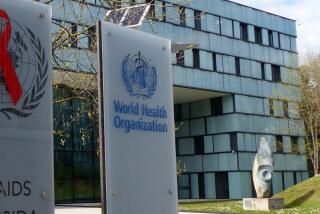Panel Presses New Ways to Assess Pollution Hazards
- Share via
WASHINGTON — A scientific commission appointed by President Clinton and Congress is recommending a far-reaching overhaul of the way the nation determines the potential risks posed by pollutants in the air, water and workplace.
If carried out, the plan could relax the nation’s attack on single sources of air pollution--factory smokestacks, for example--and launch a broader campaign on all elements contributing to fouled air. The effects would reach across American life, from factory and farm to urban air and beaches.
The revisions are expected to win the support of the Environmental Protection Agency as well as many members of Congress and industry groups. Environmental organizations so far are not opposed. The commission was established in 1994 by mandate of Clean Air Act legislation of 1990.
“The result would be cleaner air for less money than we’re spending,” said Gail Charnley, the executive director of the panel, known as the Commission on Risk Assessment and Risk Management.
Changes are needed, Charnley said in an interview, because--after a generation of cleaning up the worst water and air pollution by attacking the biggest polluters--”more and more resources are required to gain smaller and smaller advantages.”
In a report being made public today, the panel recommends that government agencies and Congress abandon the long-held practice of setting standards and regulations based on hazards posed by individual chemicals.
Rather, it says, rules that set standards for human and agricultural exposure should take into consideration a wider range of pollution sources. Specifically, the report says:
* Instead of focusing on a single major source of a pollutant, the government could identify all sources and work to reduce emissions across the board. That approach might well reduce standards for the major source while raising them for secondary sources.
* Rather than following the current, rather general approach to attacking pollution, government should develop ways to determine priorities for individual communities based on the risks found specifically in those communities.
For example, if a community has a power plant that contributes to respiratory disease and a solid waste incinerator that poses a risk of disease linked to exposure to heavy metals, researchers could compare the two and assign a higher priority to one of them.
* Consideration could be given to the interaction and cumulative impacts of various pollutants. For example, the report notes that the small particles of air pollution to which hydrocarbons are attached can increase the risk of cancer.
The panel also is calling for citizens, political officials and industries in each community to be more involved in setting the rules for their locality.
An example of the new approach might be found in the nation’s attempts to limit exposure to benzene, a chemical linked to some cases of leukemia.
Under the existing rule-making procedures, if wisps of benzene are slipping out of a factory smokestack, regulators would impose limits on how much of the chemical could be emitted in any given period. Charnley said that they would not be required to focus on such other producers of benzene as motor vehicles, the source of 60% of benzene in the air, or other benzene sources, such as cigarette smoke or household cleaning products.
The course recommended by the commission would not ignore the factory emissions, Charnley said. However, she said, “if your goal is to reduce the leukemia risk, then you might decide that only to focus on that stack will not have a detectable impact” and that greater attention should be paid to the other sources of benzene.
The recommendations reflect a recent trend in regulation, which has the support of the Clinton administration. Under the new approach, government places greater emphasis on establishing a cooperative, rather than adversarial, relationship with the industries they oversee and looks at environmental hazards in a broad context, rather than emissions from individual smokestacks.
In California, the Wilson administration has been attempting to streamline environmental regulation in general, embarking on a course that critics fear would weaken some safeguards and tolerate higher risks.
Officials at the EPA praised the report as consistent with the views the agency’s administrator, Carol Browner, has taken. “It’s definitely where she sees the future of environmental protection,” said an aide, Melissa Bonney.
A spokesman for the Chemical Manufacturers Assn. in Arlington, Va., said that the organization supports the commission’s recommendations.
“The next step will be how the government makes use of these in regulations,” spokesman Jeff Van said. “That will be important. If they do use them, we could find ourselves in short order moving toward better decision-making.”
More to Read
Sign up for Essential California
The most important California stories and recommendations in your inbox every morning.
You may occasionally receive promotional content from the Los Angeles Times.










